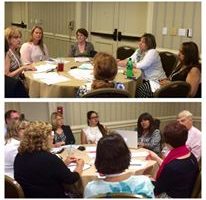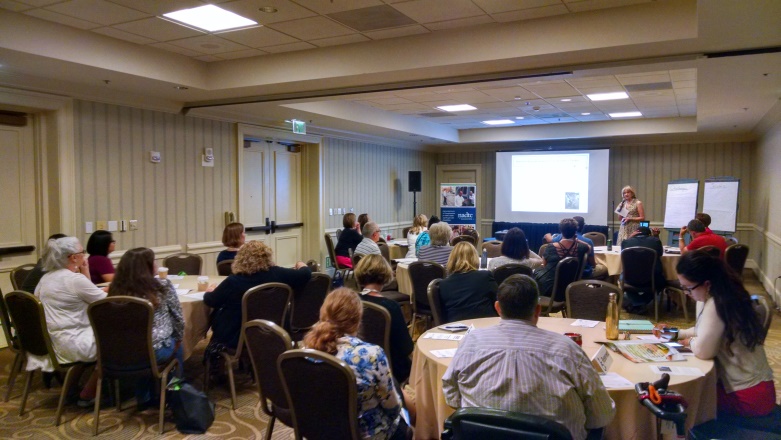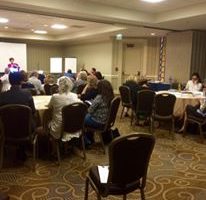NADTC Mobility Fair, July 27, 2016
Held at the National Association of Area Agencies on Aging Conference
San Diego, CA
The National Aging and Disability Transportation Center recently wrapped up a successful and exciting Mobility Fair, held July 27, 2016 at the annual National Association of Area Agencies on Aging (n4a) Conference. For the past four years, the Mobility Fair has offered Area Agencies on Aging the opportunity to come together with peers for dialogue about transportation challenges, potential solutions and best practices in the transportation field. Nearly 70 people from agencies across the country participated in these discussions over the course of this year’s event!
This year’s Mobility Fair featured three roundtable sessions:
- NADTC Transportation Listening Session;
- Filling the Mobility Gap with Volunteer Drivers; and
- Funding a Community Transportation Program: Where Does the Money Come From?
Each roundtable session highlighted the different ways transportation is making a difference in communities around the country and generated valuable ideas to improve community transportation services that meet the needs of older adults and people with disabilities. We will showcase summaries and resources from these events in blog posts throughout the next week. Stay tuned for the updates!
The next three blog posts on our website will review the discussions that took place during the Mobility Fair with staff from Area Agencies on Aging, but these are issues that many diverse agencies and programs face. Your input and perspectives are important and can help shed light on resources or ideas that are not highlighted here. We invite your reactions, thoughts, questions, and resources on any of the topics covered in these posts, so be sure to leave a comment below!
First up, NADTC Transportation Listening Session!
This open dialogue offered participants an opportunity to discuss current trends, challenges, and ideas with NADTC Staff and each other. The discussion was wide-ranging and moved from one topic to another. The following highlights encapsulate the top issues that were discussed.
- Access to Dialysis: Frequency of visits and location of clinics, especially in rural areas, create a strain on transportation providers. To help alleviate this problem, one suggestion was to collaborate with the clinics and their scheduling so that clients from the same area may have their appointments close to the same times, making pick-up and drop-off times shorter and more convenient for the passengers. Another possible solution was the utilization of Transportation Networks Companies, sometimes called ride sharing and ride-hailing apps.
- Transportation Network Companies (Ride Sharing): The discussion of the advantages, disadvantages, and variations of this form of transportation (common examples of ride-hailing apps in many urban areas include Uber or Lyft) took up a good part of the first session. Specific to the needs of older adults and people with disabilities, the advantages of these forms of transportation include the coverage of areas outside those of paratransit, shorter wait time for pick-up or drop-off, and not using cash for payment. Disadvantages include their current limit to urban areas, relatively high costs for passengers on limited incomes, lack of background checks on drivers, fewer vehicles that are wheelchair accessible, lack of community consensus about their acceptance, and reliance on smartphones to get service.
- Travel Training: Many of the organizations represented by the discussion participants fund travel training programs and older driver education, and expressed willingness to share their practices. Comment below if you have information to share and NADTC will help coordinate disseminate the information!
- Decreasing Budgets: As suggested by one participant, if you hit a wall when trying to find support or advocates in state or local government, it may be worth researching to see if any lawmakers may be personally affected by friends or family who may be having difficulties finding accessible transportation.
Resources:
- GoGoGrandparent: An app that helps to circumvent the need for a smartphone when requesting personalized transportation
- Liberty: A transportation service available in some rural areas to fill the gap when public transit, taxi service or ride sharing is unavailable. Liberty applies a community-based approach to public transportation.
- Inclusive Coordinated Transportation Project: This project, funded by the U.S. Administration on Community Living, has a primary focus on engaging people with disabilities and older adults to identify improvements in transportation that will benefit them in the community.
Our listening sessions are one of many ways NADTC is engaging stakeholder perspectives on transportation for older adults, people with disabilities, and caregivers and the above represents just a sampling of the ideas and conversation generated by the audience. What other ideas or resources might you add to expand the conversation?



Leave a Reply